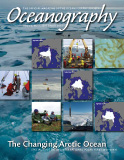Article Abstract
The Arctic Ocean traditionally has been described as an ocean with low variability and weak turbulence levels. Many years of observations from ice camps and ice-based instruments have shown that the sea ice cover effectively isolates the water column from direct wind forcing and damps existing motions, resulting in relatively small upper-ocean variability and an internal wave field that is much weaker than at lower latitudes. Under the ice, direct and indirect estimates across the Arctic basins suggest that turbulent mixing does not play a significant role in the general distribution of oceanic properties and the evolution of Arctic water masses. However, during ice-free periods, the wind generates inertial motions and internal waves, and contributes to deepening of the mixed layer both on the shelves and over the deep basins—as at lower latitudes. Through their associated vertical mixing, these motions can alter the distribution of properties in the water column. With an increasing fraction of the Arctic Ocean becoming ice-free in summer and in fall, there is a crucial need for a better understanding of the impact of direct wind forcing on the Arctic Ocean.

